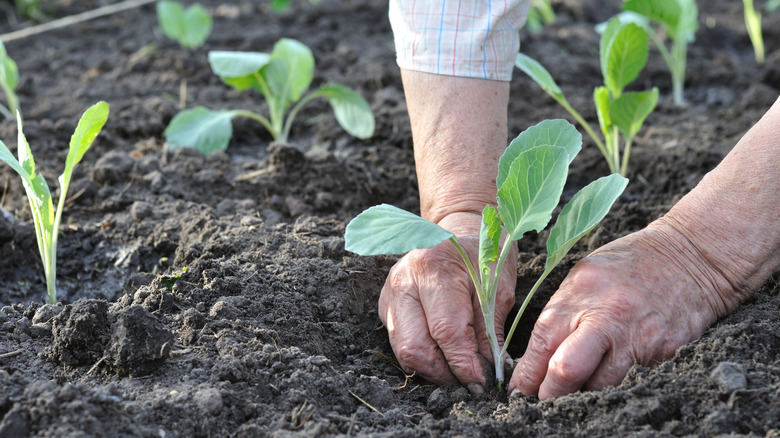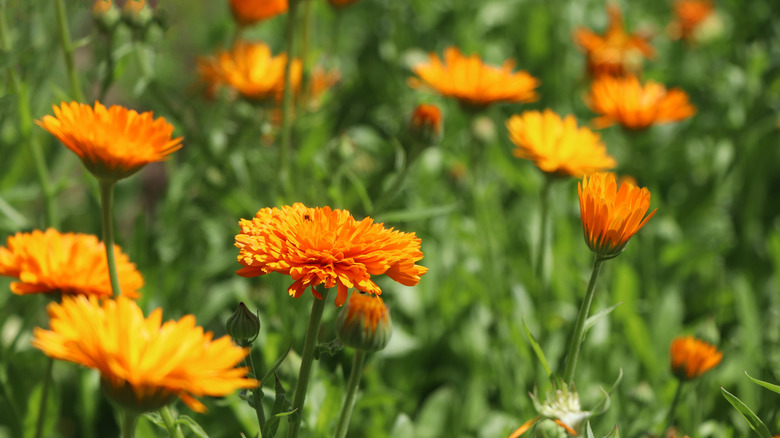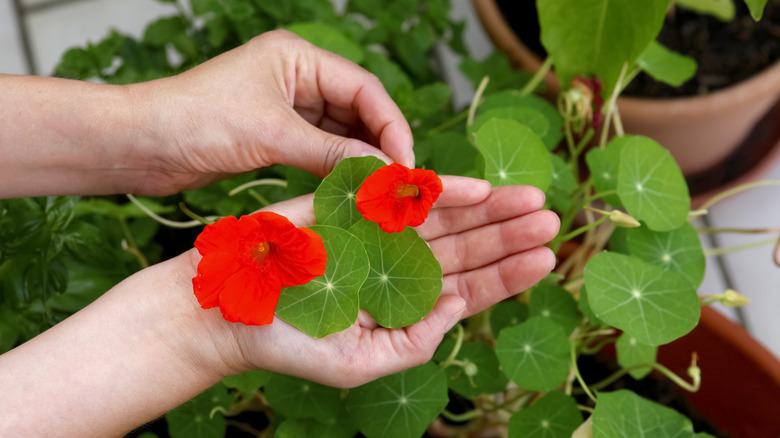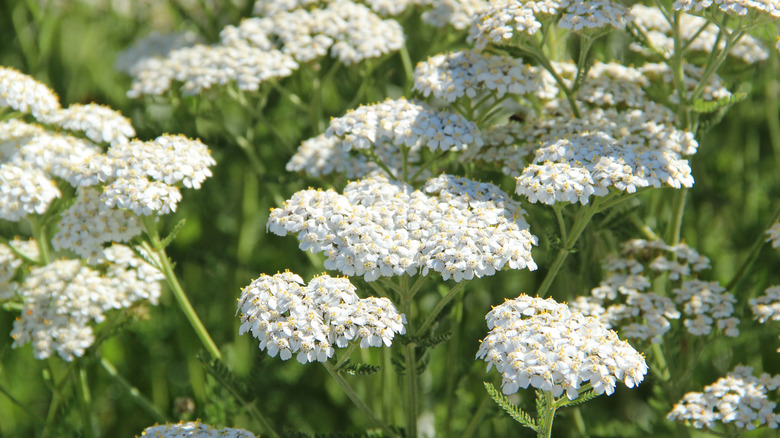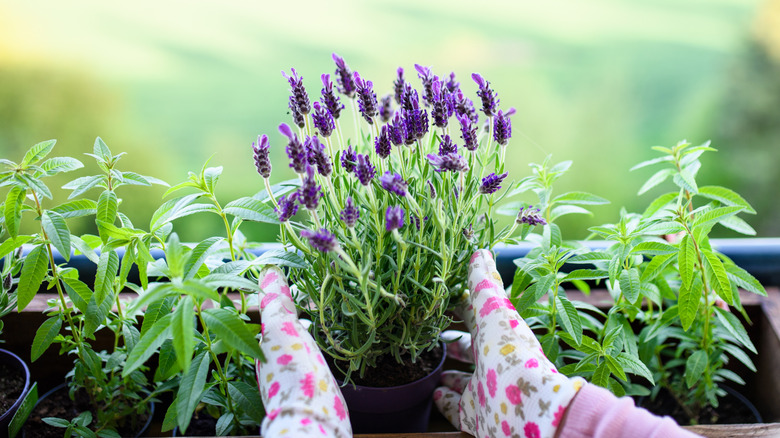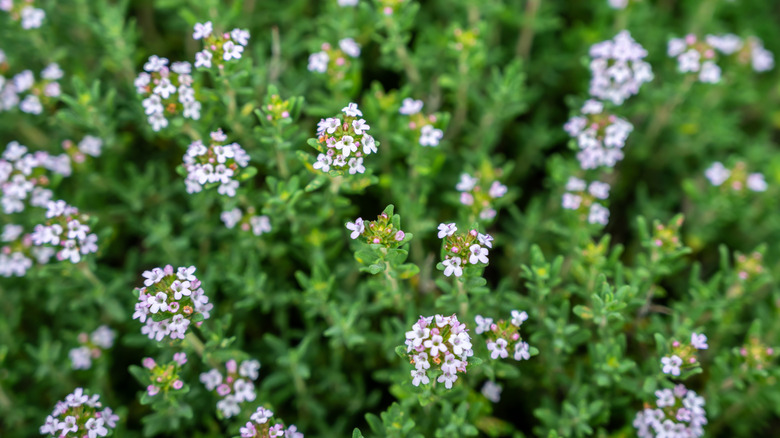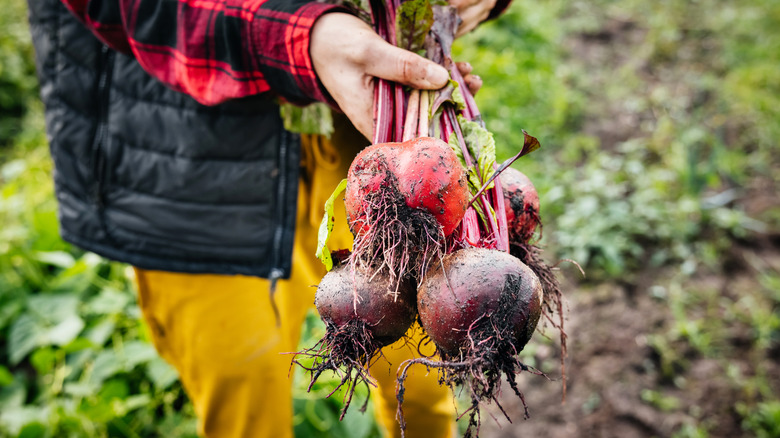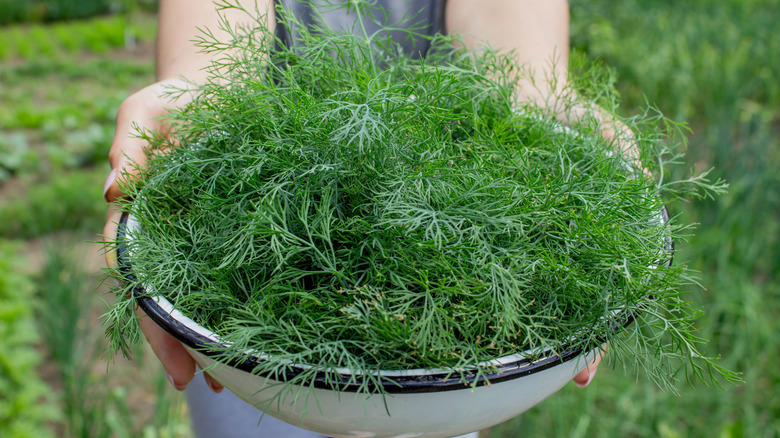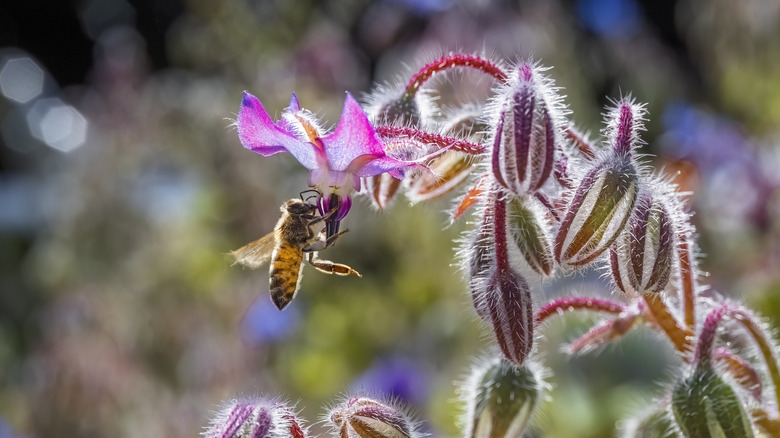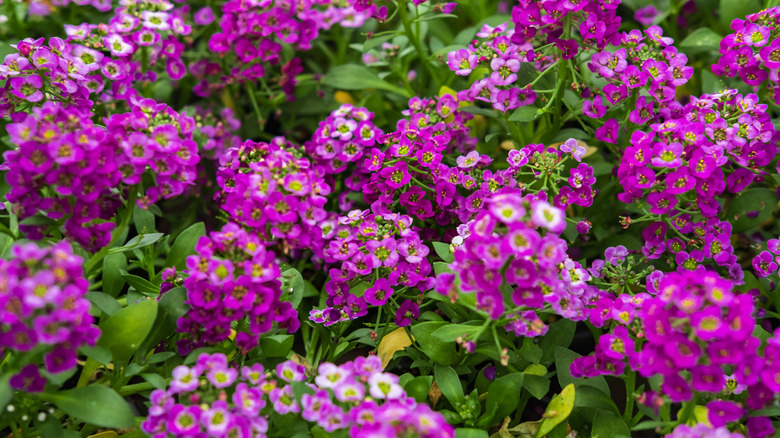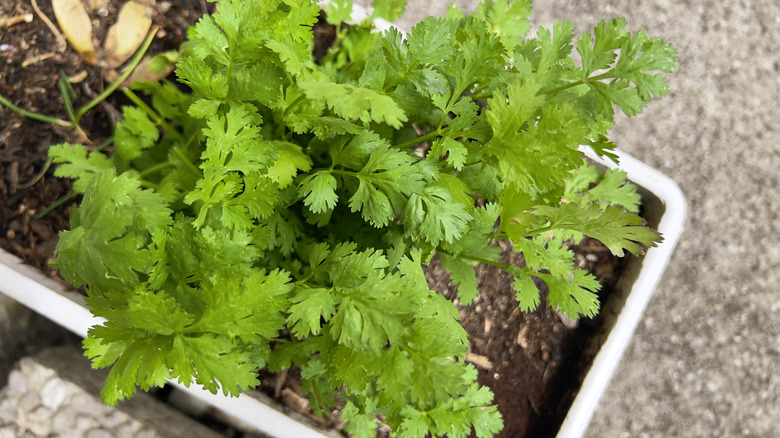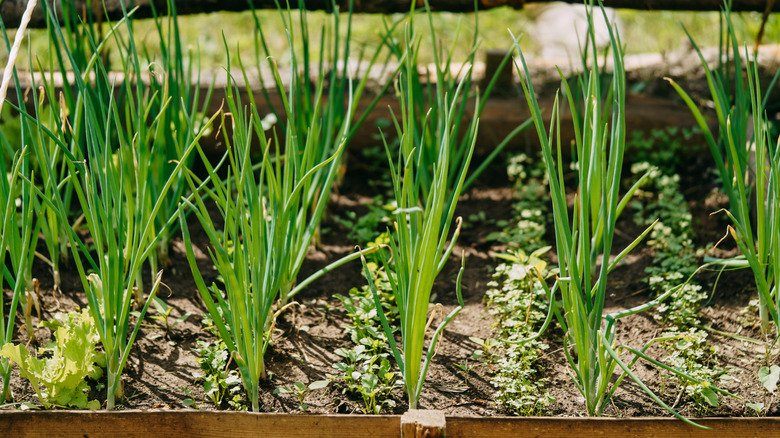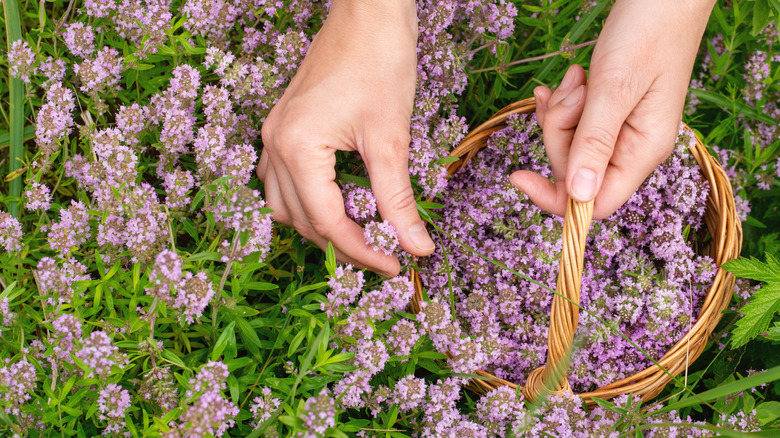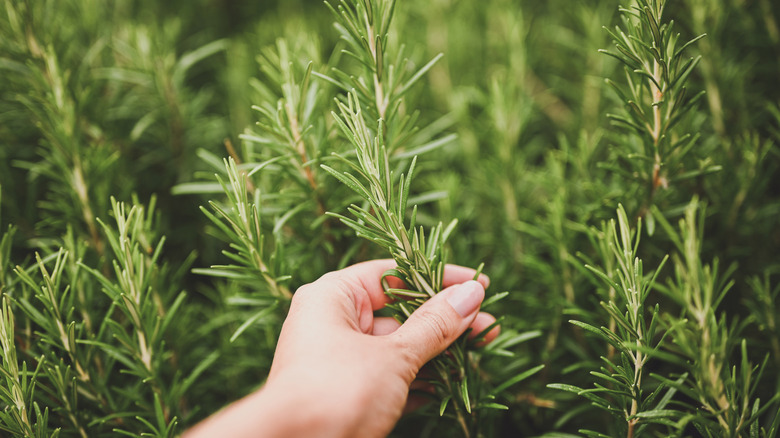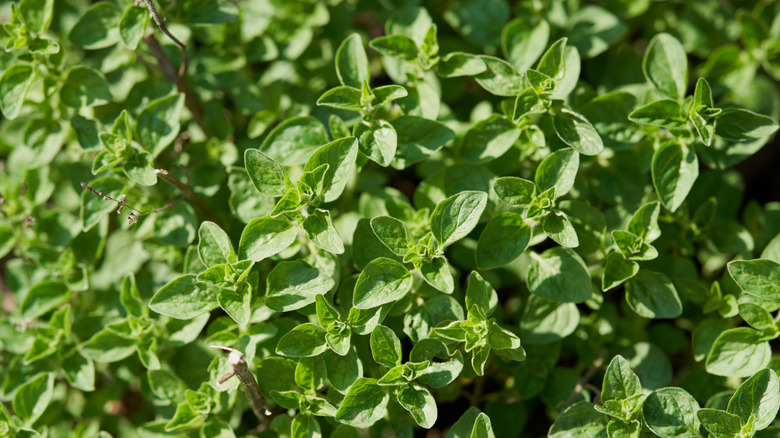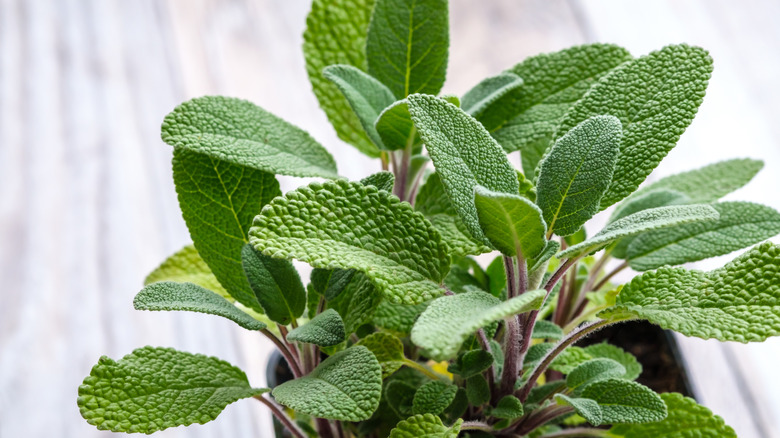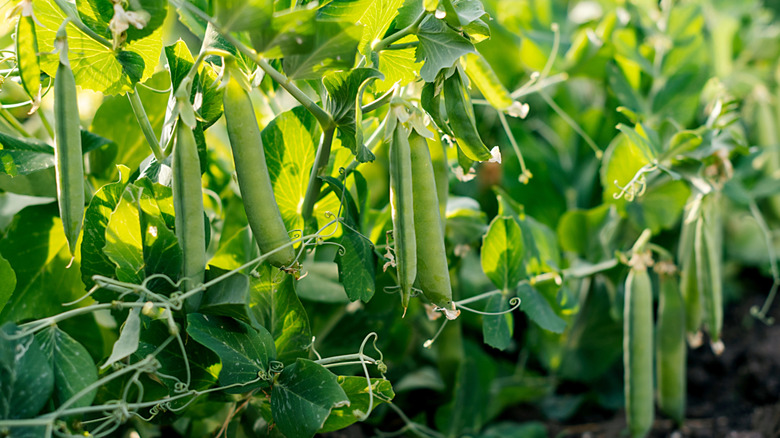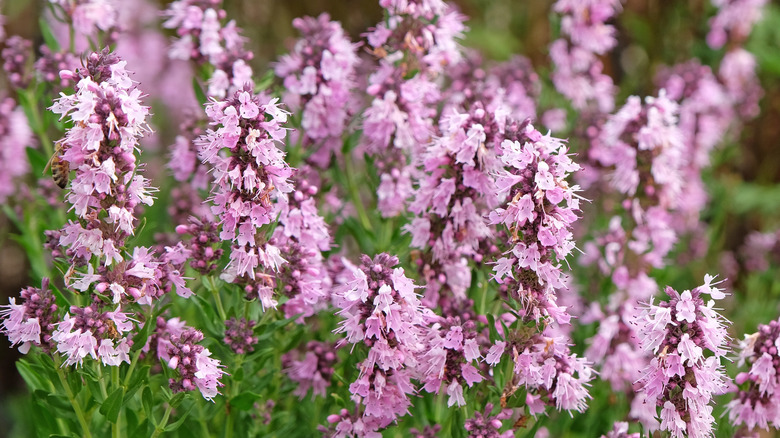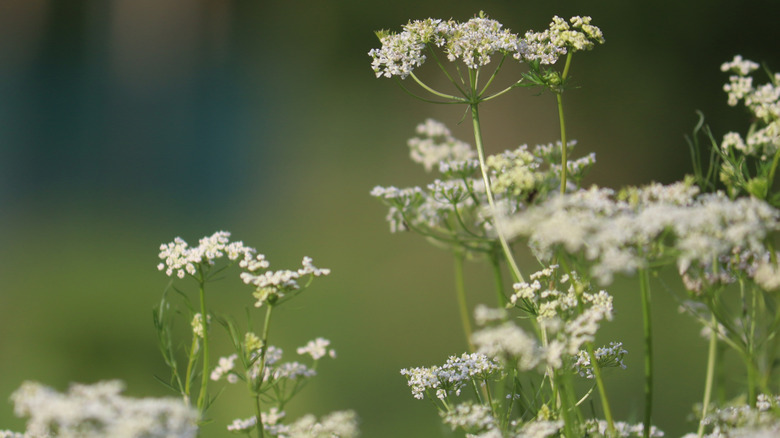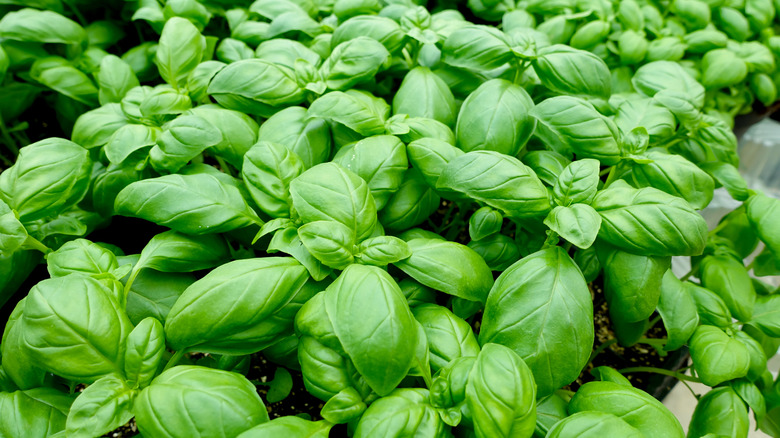22 Easy To Grow Companion Plants That Belong Beside Your Cabbage In The Garden
Cabbages are one of the easiest vegetables to grow year-round in your garden. But when it's time to harvest them, it's not unusual to find their leaves full of holes and the heads crawling with worms. That's because, as low-maintenance as cabbage seems, it's also a magnet for pests like aphids, cabbage loopers, and root maggots. Now you could deal with this by applying chemicals. They're effective, but there's a cleaner, more natural fix you could try: Companion planting.
When you surround your cabbage with the right plants, you create an ecosystem that works for you. For example, plants like thyme and sage release strong aromatic oils that help mask your cabbage from pests. Others, like nasturtium and dill, on the other hand, act as decoys and draw harmful insects like caterpillars and beetles away, or lure in the beneficial predators that eat them. And many, like beet and borage, can help improve the overall quality of your garden's soil. So, without further ado, let's get into some companion plants that will protect your cabbage and also help your entire vegetable garden thrive.
Marigold
There are plenty of good reasons to plant marigolds (Tagetes) in your garden. For one, they add a burst of orange and a pleasant scent. But that same smell, thanks to natural compounds like thiophene, is something many pests can't stand. Of course, marigolds might not keep every single troublesome one of them away, but if you're growing cabbages in particular, studies show they're pretty helpful when it comes to cutting down on pests like cabbage maggots and nematodes that live in the soil. They grow well in USDA Zones 2 through 11, with full sun and regular watering.
Calendula
Some people mistake calendula (Calendula officinalis) for marigold because they look similar. It doesn't help that it's nicknamed "pot marigold" and is also hardy to USDA Zones 2 to 11. But calendula is a different plant that equally deserves a spot beside your cabbages. It helps draw in beneficial insects like hoverflies and parasitic wasps, which keep pests like aphids and caterpillars in check. Its roots also deposit chemicals rich in thiophene that lead to significantly fewer nematode infestations. Beyond that, calendula's decaying foliage helps add organic matter back to the soil, improving your chances of growing healthy cabbage heads.
Nasturtium
Nasturtium (Tropaeolum majus) is another bright orange flowering plant that belongs in your garden for so many reasons. First of all, it's edible and is, in fact, Meghan Markle's favorite edible flower. But more importantly, it's a pretty efficient trap crop that lures cabbageworms and aphids to itself, so these pests don't get the chance to damage your cabbages. Found naturally in USDA Zones 9 to 11, nasturtium mostly grows as a perennial, but in cooler regions, it acts as an annual. Either way, it's just as low-maintenance.
Yarrow
Another low-maintenance plant you can add to your cabbage patch is yarrow (Achillea millefolium). Yarrow attracts a host of beneficial insects that prey on common cabbage pests. On top of that, its flowers are a rich nectar source for pollinators. And the more pollinator-friendly your garden is, the better. It can tolerate dry soil and is hardy in USDA Zones 3 through 9. Its deep roots help break up compacted ground, gradually improving drainage and soil structure over time. That, in turn, supports a healthier ecosystem where your cabbages and other nearby vegetables can really thrive.
Lavender
It's a good idea to consider lavender (Lavandula angustifolia) when thinking of companions for your cabbages. Lavender releases strong aromatic oils that may smell lovely to you and is perfect for making salves, potpourri, or linen spray. However, to pests like cabbage moths and whiteflies, that same scent can be disorienting, which makes it a good companion. Like yarrow, lavender also helps draw in pollinators and can tolerate dry soil. However, it thrives best in USDA Zones 5 through 9 and prefers well-drained soil. Once established, though, it's drought-tolerant.
Chamomile
Even though chamomile (Matricaria chamomilla) is more popular in tea form, the actual plant works great beside your cabbages. That's because the flowers attract predatory insects that'll eat cabbage pests. Its scent also deters these pests. But that's not all. There's a popular belief that cabbage planted near chamomile tends to have better flavor. And if you're someone who's also particular about the aesthetic appeal of your garden, you can count on chamomile to add a dainty touch with its clusters of white daisy-like flowers. It is found naturally in USDA Zones 2 to 8.
Summer savory
If you're looking for an easy-to-grow herb that's also heat-tolerant and found across USDA Zones 2 to 11, try summer savory (Satureja hortensis). Like the name suggests, its leaves have both a peppery scent and flavor. On the one hand, you can use it to spice up your dishes. On the other hand, it contains chemical compounds that make it an eco-friendly pest-management solution. It's particularly efficient at turning away cabbage moths. It also attracts beneficial pollinators such as bees.
Beet
Now, beet (Beta vulgaris) doesn't release any strong aromas like most of the other plants we've discussed so far. But it's still a great match, partly because it's a cool-season vegetable just like cabbage, thriving in USDA Zones 2 through 11. The major advantage, though, is underground. While cabbage roots tend to spread out near the surface, beet taproots grow much deeper. This helps reduce competition for water and nutrients, allowing both crops to thrive without getting in each other's way. In fact, beets help dig up nutrients, which can be a major boost for shallow-rooted plants like cabbage.
Dill
Dill (Anethum graveolens) is one of the fastest-growing plants you can pair with your beets and cabbages if you want a really tasty harvest. Beyond the flavor, because of its fern-like leaves, upright structure, and aromatic nature, dill plays a mix of visual, olfactory, and behavioral tricks on pests. For starters, its strong smell naturally repels common cabbage pests. But there's also this fascinating expert theory that when pests land on the companion and realize it's not their target, they often move on, leaving the plant safe. Dill naturally thrives in USDA Zones 2 to 11.
Borage
Some plants help your cabbage taste better. Others, like borage (Borago officinalis), are simply flowers that look beautiful while quietly improving your garden's soil. Much like beets, borage grows deep taproots that reach into the subsoil to mine minerals, break up compacted ground, and help water penetrate. When you cut it back and let the deadheads decompose, it returns those nutrients to the surface, enriching the soil over time. This, in turn, helps you grow healthier cabbages. What's more, this flower also attracts pollinators and repels common cabbage pests. It grows naturally in USDA Zones 2 to 11.
Sweet alyssum
Hoverflies can't resist the nectar in sweet alyssum (Lobularia maritima). And that's a good thing because those same hoverflies love to feast on aphids, one of the most persistent pests that damage cabbage leaves. So pairing sweet alyssum with cabbage makes perfect sense if you want a low-effort, natural way to keep your plants healthy. Cabbage, in fact, is one of the vegetables that grows particularly well beside sweet alyssum in the garden. And as a perennial in Zones 9 through 11, sweet alyssum can take some heat. Anywhere else, especially in cooler regions, it grows as an annual.
Cilantro
Do you know you can actually regrow store-bought cilantro (Coriandrum sativum)? And when you add it to your vegetable patch, it becomes a useful companion for cabbage, especially if you let it bolt. Once it starts to flower, it draws in hoverflies and parasitic wasps, which help control cabbage worms and aphids. More importantly, both plants thrive under similar growing conditions. One common mistake to avoid with companion plants is pairing plants with clashing needs. Since cilantro also prefers well-drained soil and cooler weather, it fits naturally into spring or fall planting cycles across USDA Zones 2 through 11.
Chives
You can also plant chives (Allium schoenoprasum), which grow well in USDA Zones 4 through 8. Interestingly, most members of the allium family (garlic, onions, leeks) are excellent companions for cabbage because of their strong, pest-repelling scents. But it's best not to plant alliums too closely together, as they tend to compete for nutrients. That said, companion planting still works best when you surround your main crop with multiple compatible neighbors. Because the more distractions you offer, the harder it becomes for pests to attack your cabbages. So, consider pairing chives with other suitable herbs on this list, like dill.
Thyme
To many people, thyme is just another herb that grows in USDA Zones 4 to 9. But there are so many thyme varieties that have great pest-repelling capabilities. Creeping thyme (Thymus serpyllum), in particular, attracts beneficial insects like hoverflies, which keep the pests that tend to cluster around cabbages in check. Because it forms a dense mat of foliage and produces tiny pink or purple flowers, creeping thyme also encourages pollination and helps keep your garden's ecosystem healthy and thriving.
Rosemary
Cabbage is one of those veggies that generally grow better with rosemary around. Like other aromatic herbs, rosemary (Salvia rosmarinus) gives off a pungent scent. But interestingly, it's not always the smell alone that drives pests away. Experiments on cabbage root flies have shown that surrounding cabbages with certain plants can confuse pests. When flies land on the "wrong" plant, especially those with dense or needle-like foliage, they tend to linger longer and ultimately lay fewer eggs on nearby cabbages. Rosemary's bushy growth creates exactly this kind of distraction. You'll find this plant naturally in USDA Zones 8 through 10.
Oregano
Oregano (Origanum vulgare) pairs beautifully with rosemary, both in recipes and in the garden. And just like rosemary, it pairs well with cabbage, too. That's because oregano uses its strong smell to ward off pests. It also has natural antimicrobial properties, which some studies suggest may help reduce harmful soil-borne pathogens. But beyond that, when it blooms, oregano's small purple flowers encourage pollinators to visit. Oregano is easy to grow and can thrive with very little maintenance, particularly in USDA Zones 4 to 10.
Sage
When you plant sage (Salvia officinalis) beside your cabbage, it gives off a strong scent that many insects can't stand. The aromatic compounds help mask the cabbage's scent, making it harder for pests like cabbage worms and flea beetles to find it. And because sage is low-maintenance and hardy in USDA Zones 4 through 8, it's easy to integrate into your garden. As a bonus, it also helps attract hummingbirds to your garden and suppress weeds.
Pea
Peas (Pisum sativum) are legumes, which means they help fix nitrogen in the soil, which is a bonus for any plant, especially for heavy feeders like cabbage that depend on rich, fertile ground to flourish. It has a deep taproot that also helps aerate the soil and create a better structure for roots to grow through. Additionally, decomposing foliage and roots leave behind even more nutrients on the soil surface for cabbages to enjoy. Peas grow best in spring and fall and thrive across USDA Zones 2 through 11.
Hyssop
If you want a stunning perennial flower that'll brighten your summer garden, consider hyssop (Hyssopus officinalis). Butterflies find its violet-blue blooms irresistible, making it a solid choice if you want a pollinator-friendly patch. At the same time, its minty, edible leaves have the added benefit of repelling cabbage pests. But keep in mind that hyssop is a vigorous self-seeder that thrives in USDA Zones 4 to 9. If left unchecked, it can spread quickly. While more blooms mean more pollinator activity, it's best to divide hyssop in spring to avoid crowding your cabbages.
Caraway
Caraway (Carum carvi) grows well in USDA Zones 4 to 10 and contains trace levels of limonene and carvone. These chemical compounds are sometimes used as natural pest repellents. While that improves the odds of your cabbage growing undisturbed by aphids, these compounds are unfortunately also toxic to animals. For instance, it has been linked to liver damage in cats. So, this is one herb you may have to avoid if you have pets. It's not as toxic to humans, though. However, contact with the raw plant may sometimes cause skin irritation, so ensure to wear gloves.
Basil
At this point, we understand why you might be tempted to toss every aromatic herb you can think of into your cabbage patch. Basil (Ocimum basilicum), for instance, produces a strong scent that helps turn pests away. Also, a recent trial showed that interplanting basil draws lacewings, which further reduces the presence of aphids. But just because a herb is fragrant doesn't automatically make it a good companion. You still need to make sure they're compatible. Fortunately, basil and cabbage are. They both thrive in full sun, prefer well-drained, fertile soil, and grow best across USDA Zones 2 to 11.
Neem
You may have contemplated using neem oil as a pesticide. But have you ever considered using the source material directly? Neem (Azadirachta indica) itself can be pretty useful. That's because every part of the plant, especially its leaves and seeds, contains powerful bioactive compounds like azadirachtin that interfere with the molting and feeding cycles of aphids and cabbage loopers. While it's most commonly grown as a tree in tropical regions (hardy to USDA Zone 10), neem can still play a strategic role in your garden even as a container plant or mulch.
